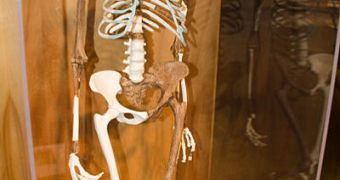A newly discovered hominid fossil, found in Ethiopia, Africa, demonstrates that humans did not evolve from knuckle-walking chimpanzees, as anthropologists widely believe. Apparently, our species evolved along a separate lineage from a common ancestor that we shared with a species of great apes that has long since been extinct, scientists say. The new, fossilized remains, named Ardi, belong to a woman that lived more than 4.4 million years ago. The skeleton was found in amazing condition, and nearly all the bones were recovered, Nature News reports.
The last common ancestor between humans and primates is believed to have lived more than six million years ago, and experts say that this makes Ardi the oldest known hominid fossil on the planet. Previously, this “record” was held by the 3.2-million-year-old Australopithecus afarensis skeleton that is popularly known as Lucy. Ardi has been named Ardipithecus ramidus. “This spectacular specimen shows why fossils really matter,” the Head of the Anthropology Department at the Yale University, in New Haven, Connecticut, Andrew Hill, argues.
Ardi was capable of walking upright, as modern humans are, but still retained a big toe similar to the one found in primates, meaning it could still grasp a tree fairly easily, for example. Also, early evidence suggests that the hominid did not use her hands for walking, as primates do even today. For comparison, Lucy had much more traits in common with the modern human. This is one of the main reasons why that fossil did not provide extensive, new knowledge on human lineage, and our species' descent.
“This specimen [Ardi] is so much more important [than Lucy] – and strange,” Pennsylvania State University in University Park biological anthropologist Alan Walker says. “Studying it may bring about a wave of considerable rethinking of not only our evolutionary past, but also that of our living relatives, the great apes,” he adds. The find, which was made in the Afar desert, some 230 kilometers Northeast of Addis Ababa, is described in a record 11 scientific papers, published in the latest issue of the top journal Science. It took 70 investigators more than 17 years to arrive to these conclusions and check and double-check them.
“The great thing about these fossils is that they illuminate a black hole in evolution 4.5 million years ago,” the Co-director of the Middle Awash Project, Tim White, explains. He is also a paleoanthropologist at the University of California in Berkeley (UCB).

 14 DAY TRIAL //
14 DAY TRIAL //